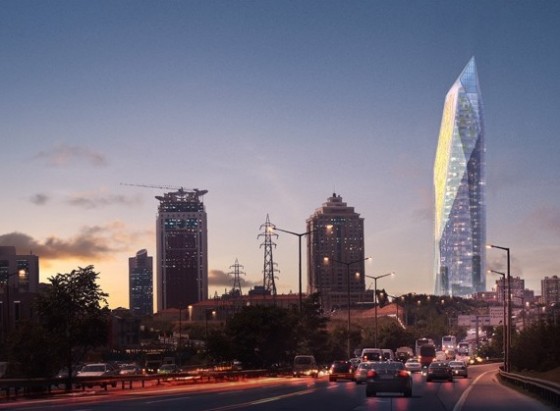Work will soon begin on the 44-story Renaissance Tower in Istanbul, Turkey. The only thing authentically Turkish here is its zip code. Image via FXFOWLE
Located on the Asian side of Istanbul at 606-feet, which is taller than most of its skyline neighbors, this “chiseled obelisk” of an office block is meant to highlight an eastern entry to this remarkable city.
What it highlights instead is a worrying trend wherein new projects earn sustainable street cred while divorcing themselves from the context of their specific sites and cultures, and where developers have opportunities to radically green up the whole building lifecycle in a legitimately newsworthy way but choose to take a pass.
This particular highrise is New York-based FXFOWLE’s first project in Turkey. Principal Architect Dan Kaplan says, “The geometric shapes of Islamic architecture and the morphemic forms of Cappadocia inspired the design.”
He continues, “Our strong desire to do something ‘Turkish’ supported the chiseled, tapering form. We wanted to make something that was part of the place.”
Kaplan says his work strives to “reduce horizontal entrophy”.
As an architect, I should understand the overblown language of our trade. Have we always sounded so ridiculous? Okay, so I’m treading snarky waters. And he’s probably a real stand-up guy. But the only thing ‘Turkish’ about this new tower is its zip code.
And what about sustainability?
Designed to achieve LEED silver certification, it boasts greywater recycling, interior daylighting and an air-distribution system that allows occupants to control individual thermal comfort.
Sustainability 101?
Draw a building as thin as Kate Moss. Skew a few angles. Slap on some bits that scream Hipster Design like faceted glass skin (takes a river to clean), decorative lighting (disturbs the night sky), and maybe plop on a needle antenna (some record-grabbing height).
Snag some free press by claiming easy-peasy green points like “access to transportation” and “use of materials with high recycled content” (cheat alert! basic ingredients in all skyscrapers are inherently green in this regard: steel, concrete, zinc, glass can be made from recycled materials, and recycled again).
Does this lazy approach to large-scale urban development really reflect the top of our creative game? With vanished financing keeping so many jobs on the drawing boards, isn’t it imperative that we press for cutting-edge excellence in those projects actually getting built?
I see more design diversity in my 12 years of plaid Catholic School uniforms than in today’s modern high rises. Their scale alone makes for monstrous environmental impact that no amount of flourescent lightbulbs or FSC-certified wood can mitigate.
Energy modelling may prove them to be more efficient than older giants of equal size, but that doesn’t make them environmentally applaudable. It’s like me wanting a prize for being the skinniest fat lady I know.
File this rant in the chunky folder named Missed Opportunities. Regrettably, the 13 million people of Istanbul are unlikely to consider this addition to their skyline a true Turkish Delight.




Margaret has a Facebook group with interesting topic along this thread: https://www.facebook.com/#!/groups/141222105976979/?notif_t=group_activity if you’d like to see what she’s up to (MidEast & North African focus).
Agree with everything Brian points out..The main concern here is keeping up with the Jones…in our case being the richer Arabic nations Again an example of wanting modern things but not having a strong network to back it up . My main concern would be the earthquake danger which is very high in Istanbul .
The problem here is that the Arab world looks eagerly to the west for futuristic green ideas without recognizing the rich value of its past. The Arab world is thousands of years older than America, and with its history are many gorgeous and successful ideas like windcatchers, and the mashrabiyas, and living communally in a family unit, ideas very divorced from the North American or Western way. Rise up Arab world and reclaim your architecture, I say.
Brian – all excellent questions. I like the Dutch approach. Design beautiful, but design so you can stay relevant for the future.
24/7 urban lights contribute to melatonin deficiency and millions of bird deaths. Excessively blue light contributes to cataracts, macular degeneration and glare. But LED highlights are about the only “green” feature which isn’t based on 1969 ecoscience and technology.
We’ve been there done that– lets move beyond this. First of all, is this building needed? Even with its enormous population, China managed to build over 60 million excess properties. Will this help Turkey catch up?
If it is needed and fits the area, does penthouse atrium help with the heat-island effect, does it help cool the building or is it just greenwashing? If this were Pyongyang, would hip western architects call it the ugliest building in the world? http://www.esquire.com/the-side/DESIGN/hotel-of-doom-012808 Will they call it ugly within the next 100 years? Seriously, buildings of this scale should be designed for at least 100 years, the Dutch design some of their projects for 10,000 years.
How much will it cost to retrofit all that glass when someone comes up with photovoltaic paint or photovoltaic windows in 10 years? Will it hold up to a 7.9 earthquake? How much heat will escape in the winter, how much will it cost to cool in the summer? Will this building be economically viable when oil is $200/bbl and electricity is 50 cents/watt? How about if water were $1/gallon?
Why are basic “green” elements of building mandated – those proven technologies to reduce energy and resource consumption – by local building codes?